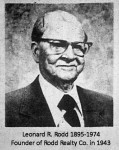 Leonard R. Rodd was born May 17, 1895, in Marion to the late G.H. Rodd and Melvina Beams. Rodd founded Rodd Realty Company and operated the business in partnership with his son, Dee L. Rodd, at 818 W. Main Street for four decades. Continue reading
Leonard R. Rodd was born May 17, 1895, in Marion to the late G.H. Rodd and Melvina Beams. Rodd founded Rodd Realty Company and operated the business in partnership with his son, Dee L. Rodd, at 818 W. Main Street for four decades. Continue reading
Category Archives: Businesses
On December 4, 1974, Dr. Ripley’s chiropractic office at 1825 W. Main Street was full of patients awaiting treatment. At 9:30, an hour after the office should have opened, an unanswered telephone prompted one of the patients to answer it. Upon opening a hallway door he discovered the body of Dr. Donald Ripley. Ripley had been shot seven times with a .45 caliber hand gun. Most of the efforts to uncover his murderer centered around a mysterious, well-dressed black man, but his killer was never found and remains one of Marion’s cold cases to this day. Continue reading
Dr. Joseph Green Parmley was born on a farm near Golconda on October 24, 1876, the son of Rev. George W. Parmley and Mary Daniel.
He attended Creal Springs Academy and Southern Illinois University before teaching school in Marion for four years. In 1904, he entered the University of Louisville, School of Medicine and graduated in 1908. Continue reading
During our recent ramble in the field of medical science we have thought now and then of Dr. G.J. Baker, the family doctor of our youth, and his wonderful pocket knife.
“Doc Griff” Baker, who delivered all three of the Felts boys and wrestled them through most of the diseases of childhood plus a siege of typhoid, was Mother’s first cousin. Day or night, rain or shine, he came on foot, carrying a little black bag in his hand and wearing a leather medicine case slung by a strap from his shoulder. Once he arrived everybody felt better. Continue reading
Paving Machine Invented in Marion Will Revolutionize the Industry
W.F. “Frankie” Merritt, 428 S. Future Street, Marion, has invented a machine which may revolutionize paving operations in the United States. Merritt, who is chief mechanic for the Regenhardt Construction Company of Cape Girardeau, Missouri, has developed a paving machine which requires no forms, but deposits the fresh concrete directly on the new road, saving approximately ten per cent in the cost of operation, and reducing the number of workers. With a traveling sub-grade machine, the results are practically the same as paving with forms. Continue reading







